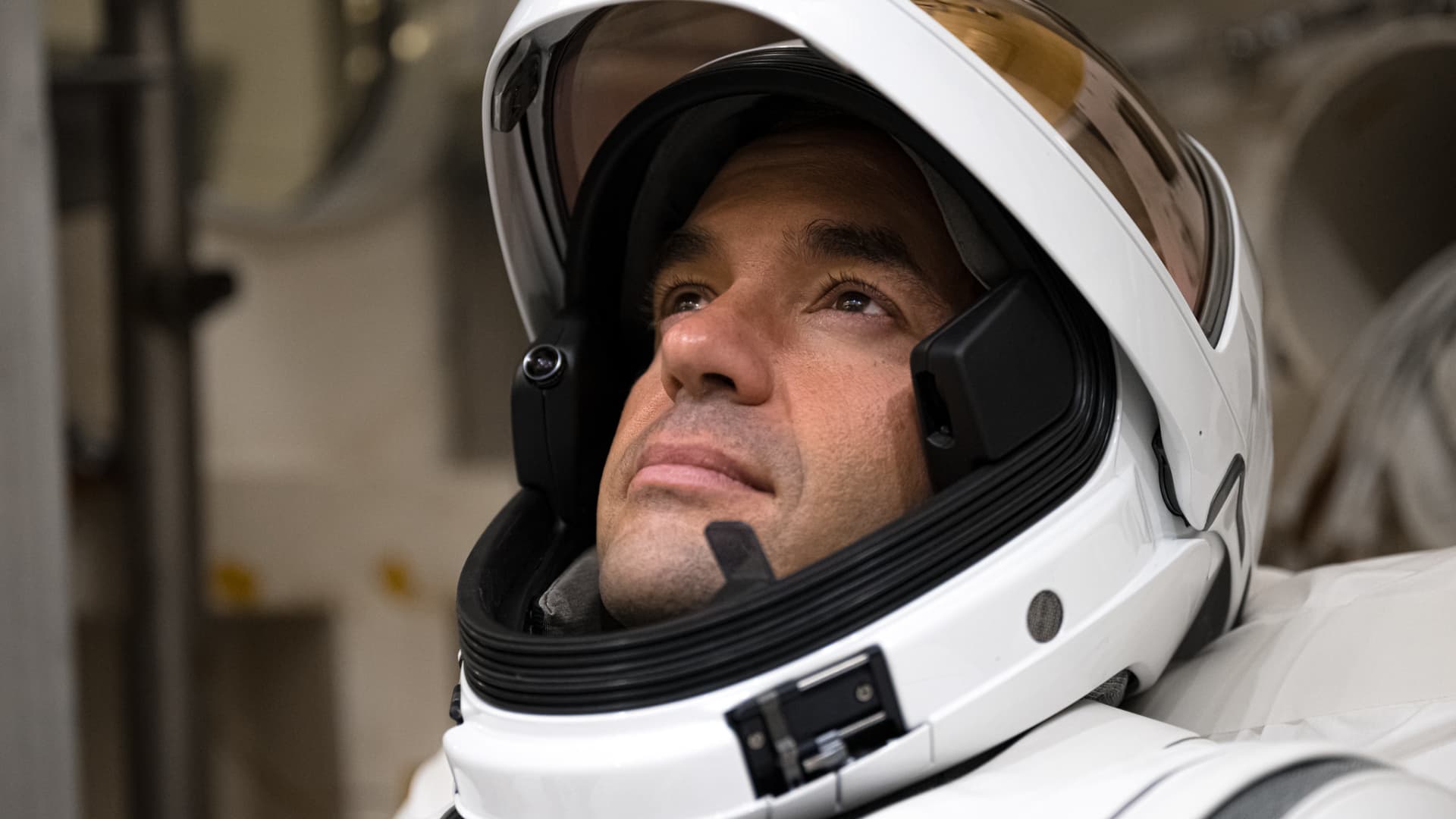Polaris Dawn commander Jared Isaacman during spacesuit testing.
John Kraus / Polaris Program
SpaceX is preparing to launch its next private mission by the end of the month, featuring the first attempt to have the astronauts step out into space.
The Polaris Dawn mission — the first of three flights billionaire and Shift4 founder Jared Isaacman purchased from SpaceX in 2022 for his human spaceflight effort known as the Polaris Program — is set to launch from Florida in the early hours of Aug. 26.
“We don’t get the freedom of any time of day to launch but I think it’ll work out to [be] pretty close to dawn, which is very appropriate given the mission,” Isaacman told CNBC’s Investing in Space during an interview last month.
Isaacman will be commanding the mission, as he did while leading the historic Inspiration4 flight in 2021. He’s once again leading a crew of four, with longtime colleague Scott Poteet joining him as the pilot and Anna Menon and Sarah Gillis, a pair of SpaceX employees, serving as the flight’s medical officer and mission specialist, respectively.
The multi-day trip isn’t headed to a destination, but instead will be a free-flying mission tracing orbits that the crew hopes will go far from Earth.
“We’re going to a very high altitude that humans haven’t gone to in 50-plus years,” Isaacman said.
The Polaris Dawn crew, from left: Anna Menon, Scott Poteet, Jared Isaacman, and Sarah Gillis.
SpaceX
But the centerpiece of Polaris Dawn is the planned spacewalk.
Extravehicular activities, or EVAs, have been a regular part of NASA’s astronaut missions for years, such as when the agency needs maintenance done outside the International Space Station. But no private venture has attempted an EVA before.
Isaacman said he understands that going for a spacewalk means he and his crew will be “surrounded by death,” a moment for which they’ve been training extensively.
“The only thing that comes close to that is the vacuum chamber, and that’s where you’re pretty much feeling as close as it’s like to be in the vacuum conditions or space. … That definitely gives you the actual sensations of the pressure changes and the temperature changes, as well as just the psychological stressors of being in a very harsh environment,” Isaacman said.
Five day mission plan
The Polaris Dawn mission crew, from left: Medical officer Anna Menon, pilot Scott Poteet, commander Jared Isaacman, and mission specialist Sarah Gillis.
Polaris Program / John Kraus
Isaacman also detailed the day-to-day schedule for Polaris Dawn, which will be in space for up to five days.
Day one is all about looking for a time when there’s minimal risk from micrometeorite orbital debris, which will determine exactly when Polaris Dawn will launch. After reaching an orbit of 190 kilometers by 1,200 kilometers, Isaacman said the crew will do extensive checks of SpaceX’s Dragon capsule Resilience.
“It’s really important to know that the vehicle has no faults before going up to 1,400 kilometers” altitude, Isaacman said.
The spacecraft will also take early passes through the high radiation zone known as the South Atlantic Anomaly.
“You ideally want to take that at the lowest altitude as you can because even down at 200 kilometers, the radiation level there is substantially higher … Our two or three passes at high altitude through the South Atlantic Anomaly will be almost the entirety of the radiation load on the mission and like an equivalency of three months on the International Space Station,” Isaacman said.
Day two will focus on some of the science and research that Polaris Dawn plans to accomplish — which will total about 40 experiments. The crew will also prep for the spacewalk, testing out the EVA suits.
“So we can make sure that … there’s nothing unexpected in microgravity versus what we were able to test on Earth,” Isaacman said.
Day three is the big one: The EVA.
The spacewalk


So who on the crew will perform the spacewalk?
“We’d say all four of us are doing it — there’s no airlock and it’s being vented down to vacuum” inside the spacecraft, Isaacman said.
Two of the crew will journey outside of Dragon: Isaacman and Gillis, while Poteet and Menon stay inside as support.
The EVA is expected to last two hours long from start to finish. Isaacman stressed that the spacewalk “is really a test and development” process.
“We want to learn as much as we can about the suit and the operation as possible, but we only have so much oxygen and nitrogen to work with,” Isaacman said.
Polaris Dawn plans to livestream the spacewalk, and the mission commander emphasized that there are going to be “a lot of cameras” scattered inside and out of the capsule.
Brand new spacesuits
A SpaceX extravehicular activity (EVA) suit during testing on June 24, 2024.
John Kraus / Polaris Program
The crucial piece of equipment intended to make the EVA possible is SpaceX’s spacesuits.
The company has spent the past couple years taking its minimalist-looking, black-and-white IVA suit —meaning intravehicular activity, and worn by astronauts in case of emergencies — and using it to create its EVA suit. Isaacman said the EVA suits are the results of hundreds of hours of testing different materials over years.
“So our primary goal is learn as much as we can about the suit,” Isaacman said.
“Everything is about building the next generation. We’re continuing to iterate on this suit design so that SpaceX can have hundreds or thousands someday for the moon, Mars, working in [low Earth orbit], what have you. Building a new EVA suit is no easy task,” he added.
Polaris Dawn medical specialist Anna Menon during spacesuit testing.
John Kraus / Polaris Program
Polaris Dawn aims to push the boundaries of private spaceflight and, like his first trip to orbit, Isaacman hopes the mission inspires.
“This is the inspiration side of it … anything that’s different than what we’ve seen over the last 20 or 30 years is what gets people excited, thinking: ‘Well if this is what I’m seeing today, I wonder what tomorrow’s gonna look like or a year after.”
Read Isaacman’s Q&A with CNBC’s Investing in Space newsletter here.















